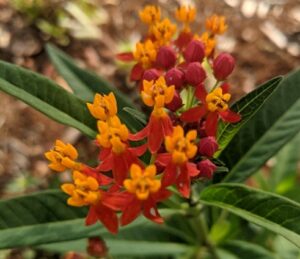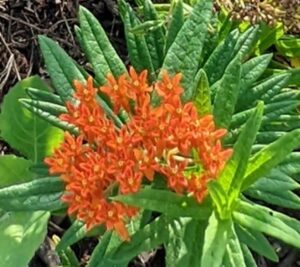Milkweed for Monarchs
Milkweed is the host plant for Monarch butterflies. The female butterflies lay their eggs on milkweed so the caterpillars can eat the leaves which allows them to build up a toxin that makes the caterpillars and butterflies undesirable to predators that may try to eat them. This toxin is also dangerous to humans so hands should always be washed after touching milkweed, especially the milky white sap inside.
Milkweed is the only plant the monarchs eat so it is essential to their survival. Luckily there are many varieties of milkweed that grow in a variety of climates allowing the monarchs the ability to migrate all over the United States and into Mexico.
Tropical Milkweed is easily identifiable by its yellow and orange flowers and can grow to be 3’ to 5’ tall. It is the easiest to find in nurseries. It is native to the American Tropics and in our area requires cutting back in the fall so it can start new clean shoots from the roots the following spring. It is also important to cut it back so the Monarch butterflies will continue their migration to Mexico and not stop here to hibernate over winter. The migration of the Monarchs helps keep the species healthy and limits the diseases they can spread to each other.
The Meadows Place Children’s Garden has been experimenting with some of the native varieties of milkweed for our area. Last Summer we grew four different native varieties and had the most success with “Aquatic Milkweed” Asclepias Perennis and “Butterfly Weed” Asclepias Tuberosa. These varieties grow to be 18” tall so they are ideal to plant within a garden around your home. Since they are native to this area they naturally die back in the fall and will reemerge from their roots in the spring.
Aquatic Milkweed has white flowers and does not need to be planted in water but seems to really like our wetter climate. Butterfly milkweed has solid orange flowers and does well in our clay heavy soil. Once established they are both drought tolerant. By planting in groups of 3 or so scattered around a garden in sunny to partly shady areas you can provide lots of space for Monarch caterpillars to hide from predators as well as allowing cross pollination of plants so you will get seedpods in the fall.
To learn more about Monarchs and supporting other native butterflies join our private Facebook group “Meadows Place Community Garden”. The Children’s Garden meets Wednesdays after school 3:45-4:30.
Written By: Krystin Stegemeier, Meadows Place Children’s Community Garden Coordinator | 713-447-6144



